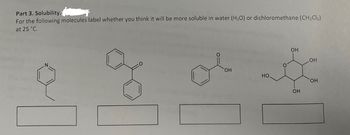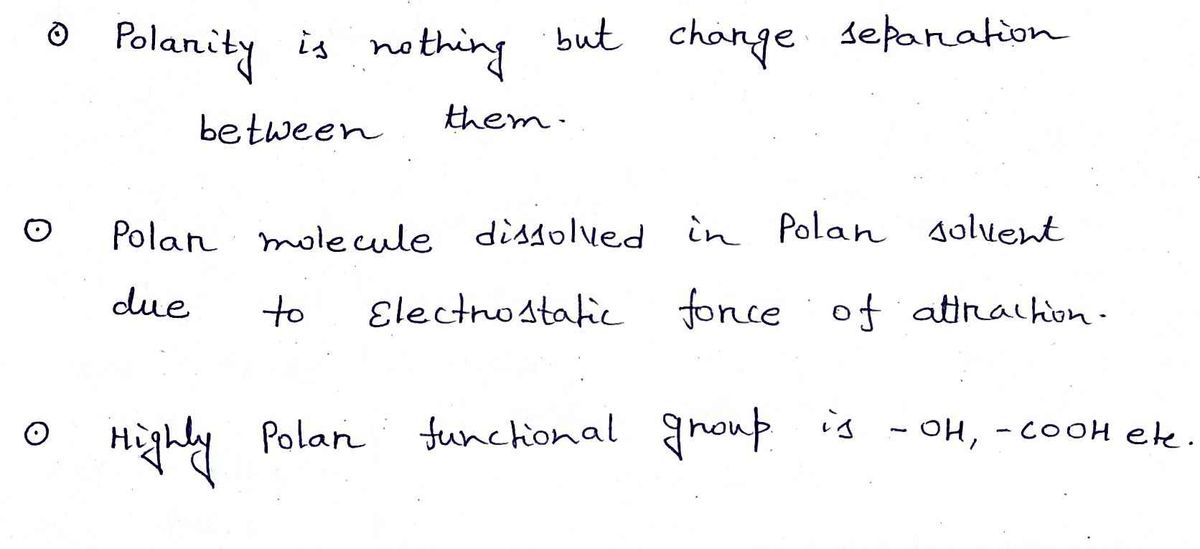
Chemistry
10th Edition
ISBN: 9781305957404
Author: Steven S. Zumdahl, Susan A. Zumdahl, Donald J. DeCoste
Publisher: Cengage Learning
expand_more
expand_more
format_list_bulleted
Question

Transcribed Image Text:Part 3. Solubility.
For the following molecules label whether you think it will be more soluble in water (H₂O) or dichloromethane (CH₂Cl₂)
at 25 °C.
OH
НО.
О
ОН
ОН
OH
OH
Expert Solution
arrow_forward
Step 1

Step by stepSolved in 3 steps with 3 images

Knowledge Booster
Learn more about
Need a deep-dive on the concept behind this application? Look no further. Learn more about this topic, chemistry and related others by exploring similar questions and additional content below.Similar questions
- Match the following aqueous solutions with the appropriate letter from the column on the right. Assume complete dissociation of electrolytes. 1.0.17 m Mn(NO3)2 2.0.16 m MgI2 3.0.22 m NHẠI 4.0.41 m Sucrose (nonelectrolyte) Submit Answer A. Highest boiling point B. Second highest boiling point C. Third highest boiling point D. Lowest boiling pointarrow_forwardUnderstanding how solubility varies with temperature and pressure.arrow_forwardA saturated solution contains more solute than solvent. contains the maximum amount of solute that will dissolve in that solvent at that temperature. contains equal moles of solute and solvent. O contains more solvent than solute.arrow_forward
- Which of the following phrases best describes the term solubility? the ability of a solvent to dissolve in a solute the ability of a solute to dissolve in a solvent the maximum amount of solute that will dissolve in solvent at a given temperature the maximum amount of solvent that will dissolve in a solute at a given temperature the amount of solvent that dissolves in a solute for each 10oC rise in temperaturearrow_forward46.29 g of KOH is dissolved in 250. mL of water. (Please pay attention to sig figs!) What is the mass percent of KOH in this solution? (use the density of water 1.00g/mL) a. b. What is the concentration, expressed in molal (m = moles solute/kg solvent), of this initial solution? What is the concentration, expressed in molar (M = moles solute/liters solvent), of this initial solution? (assume that the addition of the KOH to the water did not change the C. volume, which is still 250.mL) d. If I add 500.mL of pure water to this 250.mL solution, what is the new concentration expressed in molar (M)? (Careful, what is the new volume after mixing?) e. If, instead, I took the 250. mL solution and evaporated the water until the solution had a volume of 150.mL, what would be the concentration of this this new solution expressed in molar (M)?arrow_forwardThe solubility of a compound is 84 g per 100.0 g solvent at 25 °C. If 84 g of the compound is dissolved in 200.0 g of solvent at 25 °C, the solution is dilute unsaturated saturated supersaturatedarrow_forward
- ! T 1 A Z The names and chemical formulae of some chemical compounds are written in the first two columns of the table below. Each compound is soluble in water. Imagine that a few tenths of a mole of each compound is dissolved in a liter of water. Then, write down in the third column of the table the chemical formula of the major chemical species that will be present in this solution. For example, you know water itself will be present, so you can begin each list with the chemical formula for water (H₂O). -6 Note: "major" chemical species are those present in concentrations greater than 10 mol/L. 89 FI compound propylene glycol Explanation ammonium lodide @ 2 glycerol W S X command Check 30: F2 # 3 formula C,H, (OH)₂ C₂H₂O, NH₂L 20 E E D 8.0 F3 C $ 4 R major species present when dissolved in water F a F4 % 5 V 0 0 T I F5 G 6 B F6 Y 7° H X & 7 00 stv N K F7 U 0.0.... 3 J © 2023 McGraw Hill LLC. All Rights Reserved. Terms of Use | Privacy Center | A- alt ✓ A A C 8 DII FB 1 M ( 9 K F9 O <…arrow_forwardUnderstanding how solubility varies with temperature and pressure.arrow_forwardanswer the attached questionarrow_forward
- Please helparrow_forwardCalculate grams of sucrose that must be added to 112.5 grams of water to prepare a 12.5 % by mass solution. a. 32.1 b. 16.1 c. 8.04 d. 0.244 e. 48.2arrow_forwardConcentrated sulfuric acid is 98.0 % H₂SO4 by mass. Calculate the molarity of this solution if the density of 1.83 g/mL. 18.0 M 0.016 M 6.01 M 3.22 Marrow_forward
arrow_back_ios
SEE MORE QUESTIONS
arrow_forward_ios
Recommended textbooks for you
 ChemistryChemistryISBN:9781305957404Author:Steven S. Zumdahl, Susan A. Zumdahl, Donald J. DeCostePublisher:Cengage Learning
ChemistryChemistryISBN:9781305957404Author:Steven S. Zumdahl, Susan A. Zumdahl, Donald J. DeCostePublisher:Cengage Learning ChemistryChemistryISBN:9781259911156Author:Raymond Chang Dr., Jason Overby ProfessorPublisher:McGraw-Hill Education
ChemistryChemistryISBN:9781259911156Author:Raymond Chang Dr., Jason Overby ProfessorPublisher:McGraw-Hill Education Principles of Instrumental AnalysisChemistryISBN:9781305577213Author:Douglas A. Skoog, F. James Holler, Stanley R. CrouchPublisher:Cengage Learning
Principles of Instrumental AnalysisChemistryISBN:9781305577213Author:Douglas A. Skoog, F. James Holler, Stanley R. CrouchPublisher:Cengage Learning Organic ChemistryChemistryISBN:9780078021558Author:Janice Gorzynski Smith Dr.Publisher:McGraw-Hill Education
Organic ChemistryChemistryISBN:9780078021558Author:Janice Gorzynski Smith Dr.Publisher:McGraw-Hill Education Chemistry: Principles and ReactionsChemistryISBN:9781305079373Author:William L. Masterton, Cecile N. HurleyPublisher:Cengage Learning
Chemistry: Principles and ReactionsChemistryISBN:9781305079373Author:William L. Masterton, Cecile N. HurleyPublisher:Cengage Learning Elementary Principles of Chemical Processes, Bind...ChemistryISBN:9781118431221Author:Richard M. Felder, Ronald W. Rousseau, Lisa G. BullardPublisher:WILEY
Elementary Principles of Chemical Processes, Bind...ChemistryISBN:9781118431221Author:Richard M. Felder, Ronald W. Rousseau, Lisa G. BullardPublisher:WILEY

Chemistry
Chemistry
ISBN:9781305957404
Author:Steven S. Zumdahl, Susan A. Zumdahl, Donald J. DeCoste
Publisher:Cengage Learning

Chemistry
Chemistry
ISBN:9781259911156
Author:Raymond Chang Dr., Jason Overby Professor
Publisher:McGraw-Hill Education

Principles of Instrumental Analysis
Chemistry
ISBN:9781305577213
Author:Douglas A. Skoog, F. James Holler, Stanley R. Crouch
Publisher:Cengage Learning

Organic Chemistry
Chemistry
ISBN:9780078021558
Author:Janice Gorzynski Smith Dr.
Publisher:McGraw-Hill Education

Chemistry: Principles and Reactions
Chemistry
ISBN:9781305079373
Author:William L. Masterton, Cecile N. Hurley
Publisher:Cengage Learning

Elementary Principles of Chemical Processes, Bind...
Chemistry
ISBN:9781118431221
Author:Richard M. Felder, Ronald W. Rousseau, Lisa G. Bullard
Publisher:WILEY